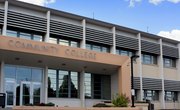Students and parents often find themselves lamenting high college price tags, and college costs are steadily rising. According to the National Center for Education Statistics, when college costs are adjusted for inflation, the average cost of a year of college in 1981 was $3,101. In 2011, however, the figure was $18,497. The picture of rising college costs is a complex one, but rising college costs can hit financially strapped students especially hard.
Budget Cuts
A 2012 report by the American Institutes for Research found that taxpayer subsidies of public universities covered fewer costs in 2010 than in previous years. Budget cuts have hit public institutions especially hard, and schools often have to raise tuition to cover costs. Even private schools may lose money when education budgets are slashed because this limits their access to grants and similar subsidies. These tuition-boosting budget cuts also can cause students and their families to face budget cuts of their own. Students might have to reduce their course hours or cut other items from their budgets to be able to attend school.
Student Loans
Two-thirds of 2011 college seniors graduated with debt, averaging $26,600 in loans, according to The Project on Student Debt. College loans can drive up the price of education because they enable students and their families to pay higher costs. When students and parents don't pay out of pocket, they may be less concerned by exorbitant costs. Consequently, colleges don't have to worry as much about losing students if they raise tuition costs. This creates a cycle in which student loans play a role in tuition hikes, and then tuition hikes force students to take out even more money in loans.
Dropping Out
One of the most serious consequences of tuition increases is a rise in the college dropout rate. Forty-four percent of students enrolled in college fail to obtain a bachelor's degree within six years, and the high cost of college can be a major factor in the decision to drop out, according to a 2011 Harvard Graduate School of Education study.
Fees and Staff
A significant portion of college costs are actually activity and miscellaneous fees. At Georgia State University, for example, students have to pay $1,117 in fees in addition to $4,014 in tuition. A 2013 report published by the Delta Cost Project emphasized that administrative costs, student activities and athletics can lead to significant hikes in tuition and fees. Colleges also have to employ more financial aid officers as the number of students using financial aid increases, and these costs also can drive up tuition.
Related Articles
References
- National Association of Student Financial Aid Administrators: Myths and Realities About Rising College Tuition
- The Fiscal Times: 12 Reasons College Costs Keep Rising
- The New York Times: College May Become Affordable for Most in U.S.
- Harvard College of Education: Pathways to Prosperity
- National Center for Education Statistics: Tuition Costs of Colleges and Universities
- The Project on Student Debt: State by State Data
- The University of Georgia: Tuition and Fees
Writer Bio
Van Thompson is an attorney and writer. A former martial arts instructor, he holds bachelor's degrees in music and computer science from Westchester University, and a juris doctor from Georgia State University. He is the recipient of numerous writing awards, including a 2009 CALI Legal Writing Award.










